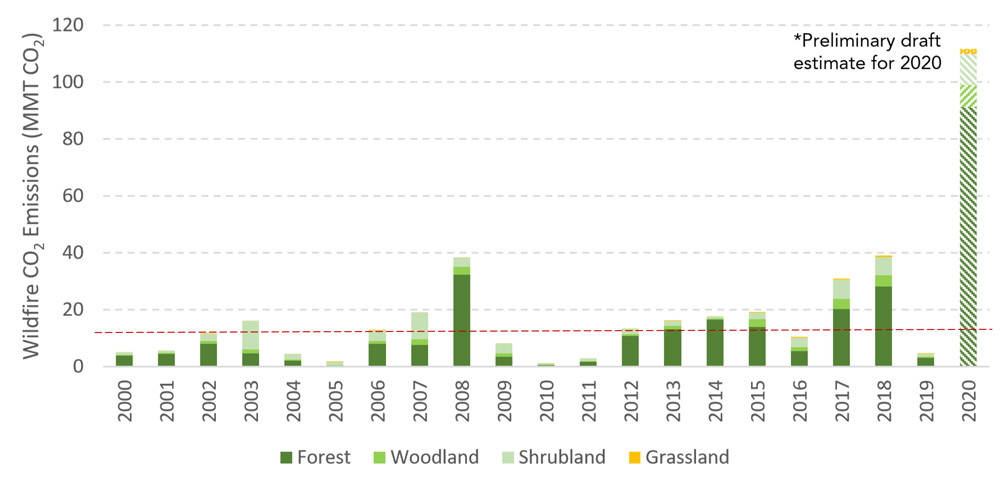California’s efforts to boost the role that natural and working lands play in the state’s climate strategy are gaining momentum as officials draft strategic plans and allocate funding for programs including those aimed at reducing wildfire severity.
The California Natural Resources Agency (CNRA) expects to release for public comment this summer a draft Natural and Working Lands Climate Smart Strategy. The agency hopes to finalize the strategy in the fall.
Some hints of what the strategy might contain came in a report released last month by an advisory panel working with the CNRA. The group, whose members are mainly in academia, recommended accelerating “climate smart land management,” including practices to reduce wildfires.
“Immediately implement a shift from reactive fire suppression in forests to proactive vegetation management, prescribed and cultural burns, and managed natural wildfire to reduce the risk of catastrophic wildfire under climate change while taking steps to minimize the effects on air quality,” the advisory group said.

The panel also recommended increasing reforestation efforts in areas hit by severe wildfires and encouraging sustainable forest practices in working forests.
Intertwined Plans
CNRA’s Natural and Working Lands Climate Smart Strategy comes as the California Air Resources Board (CARB) plans to increase its emphasis on natural and working lands in its upcoming 2022 scoping plan. The scoping plan, which is an update to a 2017 plan, will serve as a blueprint for the state to reach carbon neutrality by 2045.
The two agencies are following instructions from an executive order that Gov. Gavin Newsom issued in October. The order directs CNRA to develop a Natural and Working Lands Climate Smart Strategy within a year and also instructs CARB to use the strategy to update carbon-reduction targets for natural and working lands as part of the scoping plan process.
In a news release announcing the executive order, CNRA described the actions as “enlist[ing] nature to store carbon, protect biodiversity and build climate resilience.”
CARB hosted a series of workshops last month as part of its kickoff for the 2022 scoping plan, including a workshop on natural and working lands.
During the workshop, Jessica Morse, CNRA’s deputy secretary for forest resources management, said the state has dramatically boosted funding for fire resilience — from $75 million last year to $1 billion this year. Part of the $1 billion came as a $536 million emergency appropriation in April, she said.
Morse said the funding will cover areas including upgrading homes to make them more fire resistant, establishing defensible space and fuel breaks that will make it harder for fires to spread to homes, and investing in fire-resistant landscapes.
Some of the funds will go toward workforce development, Morse said, with training available for forest crews, fuel-reduction crews and prescribed fire crews.
In addition, some of the money will go into a climate catalyst fund, intended to spur innovation in uses for woody biomass. That material might include invasive shrubs removed from rangelands, forest undergrowth or small-diameter trees. Morse said traditional markets for those materials are lacking.
“Our goal is to ensure that all of this woody material coming off the forest, that we want as little of it pile-burned as possible,” Morse said. “We want as little of it chipped and landfilled as possible.”
Farmers Weigh In
Another piece of Newsom’s executive order from October instructed the California Department of Food and Agriculture (CDFA) to identify farmer- and rancher-led solutions during CARB’s scoping plan process.
During last month’s CARB workshop, CDFA Senior Environmental Scientist Michael Wolff detailed the agency’s progress. In February, the agency hosted six online listening sessions, focused on dairy and livestock, perennial crops, and annual crops.
Certain themes emerged among the comments from the 323 attendees. Farmers and ranchers support incentives but are worried about over-regulation, Wolff said. Smaller farms need financial assistance in order to take on the risk associated with new technology and equipment, according to the comments.
And some said they’d like to see more recognition of the climate benefits of keeping land in agricultural use rather than converting it to urban use.
Wolff said the next step is to further evaluate the suggestions to determine how soon each could be implemented and what resources would be needed.



